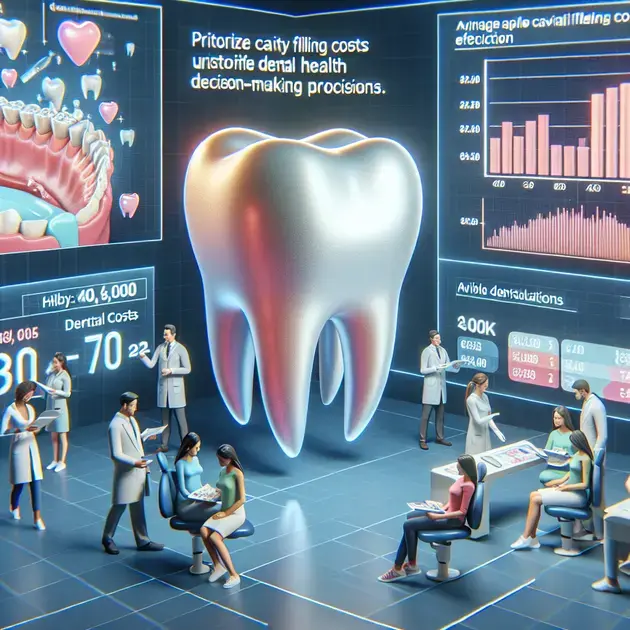When it comes to oral health, understanding the cost of cavity fillings is essential. In this ultimate guide, we will delve into all you need to know about cavity filling costs, including factors that can influence the overall price.
With the rising expenses of healthcare services, knowing the average cost of cavity fillings can help you budget for your dental care more effectively. Stay tuned as we break down the various aspects of cavity filling costs and provide insight on how you can manage these expenses.

Factors Affecting Cavity Filling Costs
When it comes to understanding the factors that influence the costs of cavity fillings, several key elements come into play. These include the type of filling material used, the location of the dental practice, the complexity of the cavity, and any additional procedures required.
One of the primary factors affecting cavity filling costs is the type of filling material chosen. For example, amalgam fillings are generally more cost-effective than composite fillings. The location of the dental practice can also impact costs, with practices in urban areas typically charging higher fees than those in rural areas.
Furthermore, the complexity of the cavity itself plays a significant role in determining the final cost. Deeper or larger cavities may require more extensive treatment, leading to higher expenses. Additionally, if the cavity is located in a hard-to-reach area, such as between teeth, the cost may increase due to the additional time and effort required.
It’s essential to consider any additional procedures that may be necessary during the cavity filling process. These can include X-rays, anesthesia, or the need for a dental crown to restore the tooth’s integrity. Each of these factors can contribute to the overall cost of the cavity filling.
To manage cavity filling costs effectively, it’s crucial to discuss all potential expenses with your dentist upfront. Get a clear breakdown of the fees associated with the procedure and inquire about any available payment plans or financing options. By understanding the factors that affect cavity filling costs, you can make informed decisions about your oral health care.
Average Cost of Cavity Fillings Explained
Understanding the average cost of cavity fillings can help you budget for this essential dental procedure. On average, the cost of a cavity filling in the United States ranges from $100 to $300 per filling. However, this cost can vary depending on several factors, including the ones mentioned above.
One way to ensure you are getting a fair price for your cavity filling is to compare costs between different dental practices. Websites such as OpineOutpost.com offer valuable resources for comparing dental procedure costs in your area. By researching and obtaining quotes from multiple dentists, you can determine the average cost and find the best option for your budget.
It’s also essential to consider any dental insurance coverage you may have that could offset some of the costs associated with cavity fillings. Review your insurance policy to understand what is covered and what percentage of the cost you are responsible for. Taking advantage of insurance benefits can help make cavity fillings more affordable.
Additionally, some dental schools and community clinics offer lower-cost dental services, including cavity fillings, as part of their training programs. While these options may take longer due to student supervision, they can provide a cost-effective solution for individuals on a tight budget.
By researching average cavity filling costs, comparing prices, utilizing insurance benefits, and exploring alternative care options, you can effectively manage the expenses associated with this essential dental procedure.
Tips for Managing Cavity Filling Expenses
Managing cavity filling expenses efficiently involves proactive planning and consideration of various cost-saving strategies. One effective tip is to prioritize preventive dental care, such as regular cleanings and check-ups, to catch cavities early and avoid more extensive treatment.
Another useful tip is to inquire with your dentist about any available discounts or promotional offers for cavity fillings. Some practices may offer specials for new patients or provide reduced rates for individuals without dental insurance. Taking advantage of these opportunities can help lower your out-of-pocket expenses.
Consider scheduling your cavity filling during off-peak times or on specific days when dental practices may offer discounted rates. By being flexible with your appointment scheduling, you may be able to secure a lower price for your procedure.
Exploring flexible payment options, such as dental financing plans or health savings accounts, can also help make cavity fillings more affordable. Many practices offer payment plans that allow you to spread out the cost of treatment over time, easing the financial burden.
Lastly, don’t hesitate to seek a second opinion if you are unsure about the recommended treatment plan or associated costs. Getting a second evaluation from another dentist can provide valuable insights and potentially reveal alternative, more cost-effective solutions for your cavity filling needs.

**Factors to Consider Before Getting a Cavity Filling**
Understanding the Importance of Dental Health
Before getting a cavity filling, it’s essential to consider the overall importance of dental health. Neglecting cavities can lead to more severe oral health issues down the line, such as infections or abscesses. By addressing cavities promptly, you can prevent these complications and maintain a healthy smile.
Evaluating Treatment Options
When considering a cavity filling, it’s crucial to evaluate all available treatment options. Depending on the size and location of the cavity, your dentist may recommend different types of fillings, such as amalgam or composite fillings. Understanding the pros and cons of each option can help you make an informed decision about your dental care.
Assessing Financial Considerations
Another factor to consider before getting a cavity filling is the financial aspect of the procedure. Dental treatments can be costly, so it’s important to review your budget and explore potential payment plans or financing options. Some dental insurance plans may also cover a portion of the costs, so be sure to check your coverage before proceeding with the filling.
Understanding the Procedure
Prior to getting a cavity filling, it’s beneficial to understand the procedure itself. Your dentist can walk you through the process, including any necessary preparations and post-treatment care instructions. Knowing what to expect can help alleviate any anxiety or concerns you may have about the filling.
Considering Long-Term Oral Health
Lastly, consider the impact of a cavity filling on your long-term oral health. By addressing cavities promptly, you can prevent further decay and preserve the strength of your teeth. Maintaining regular dental check-ups and practicing good oral hygiene habits can help prevent future cavities and preserve your smile for years to come.
Conclusion
Before getting a cavity filling, it’s crucial to prioritize your dental health. Ignoring cavities can lead to more severe issues like infections, emphasizing the importance of timely treatment to maintain a healthy smile.
Exploring treatment options
It is essential to evaluate different types of fillings like amalgam or composite based on cavity size and location. Understanding the advantages and disadvantages of each helps in making an informed decision regarding your dental care.
Financial planning and procedure insight
Considering financial implications before a filling is key. Review your budget and inquire about payment plans or insurance coverage. Additionally, understanding the procedure, its preparations, and aftercare instructions can ease any apprehensions you might have.
Long-term oral health benefits
Addressing cavities promptly not only prevents decay but also enhances the durability of your teeth. Regular dental check-ups and good oral hygiene practices play a vital role in preventing future cavities, safeguarding your smile for years to come.